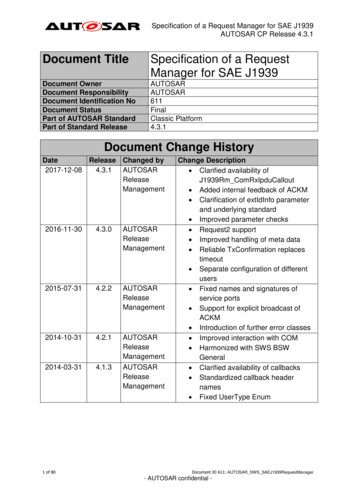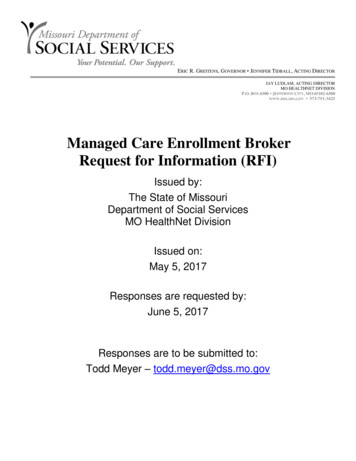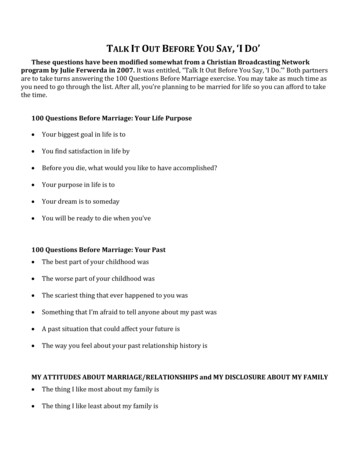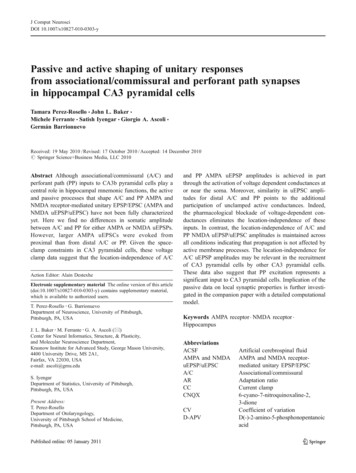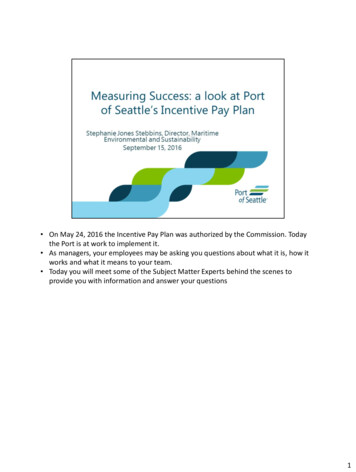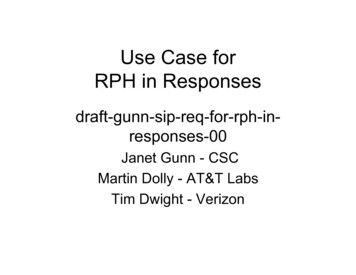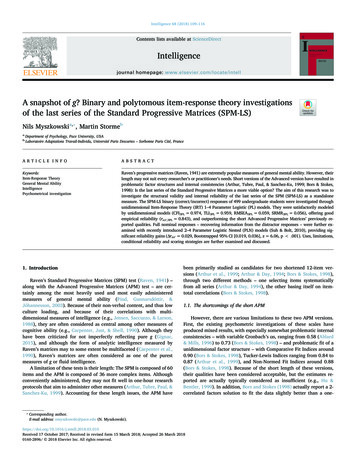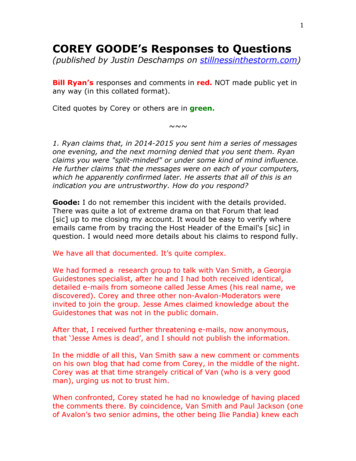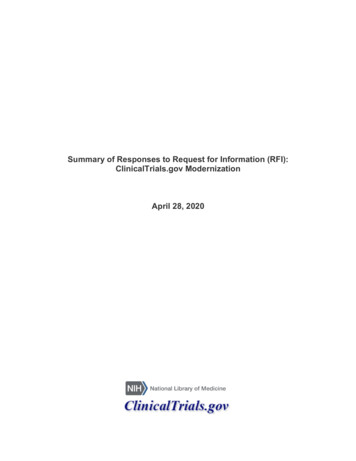
Transcription
Summary of Responses to Request for Information (RFI):ClinicalTrials.gov ModernizationApril 28, 2020
ContentsBackground . 1Methods. 1Results . 21. ClinicalTrials.gov Website Functionality . 31a. Examples of New Uses of the ClinicalTrials.gov Website . 31b. Resources to Link to from ClinicalTrials.gov. 31c. Examples of Current Uses of the ClinicalTrials.gov Website . 41d. Scope of the Primary Uses of ClinicalTrials.gov. 42. Information Submission through the PRS . 52a. ClinicalTrials.gov Registration and Results Submission Process and Improvements . 52b. Alignment of the PRS Submission Process with Organizational Processes . 52c. Novel Methods to Enhance PRS Information Quality. 52d. Useful Submission-Related Materials. 62e. Incentives and Recognition for Information Submission . 63. Data Standards to Support ClinicalTrials.gov . 63a. Balance Between Standards and Flexibility . 63b. Examples of Useful Standards . 6Conclusions . 7Appendix: Questions from the Request for Information (RFI):ClinicalTrials.gov Modernization . 8i
BackgroundClinicalTrials.gov is the world’s largest public clinical research registry and results database.This resource provides information on more than 336,000 clinical studies and 42,000 results for awide range of diseases and conditions. More than 3.5 million visitors use this public websiteeach month to find and learn more about clinical trials. The National Library of Medicine (NLM)maintains ClinicalTrials.gov on behalf of the National Institutes of Health (NIH).NLM has launched an effort to modernize ClinicalTrials.gov to improve the user experience byupdating the platform to accommodate growth and enhance efficiency. To obtain detailed andactionable input, NLM issued a request for information (RFI), NOT-LM-20-003, onDecember 30, 2019. The RFI’s purpose was to solicit comments on the ClinicalTrials.govwebsite’s functionality, information-submission processes, and use of data standards. NLMaccepted comments and attachments via a web-based form until March 14, 2020.The RFI questions were grouped into three broad topic areas:1. Functionality of the ClinicalTrials.gov website, including how the site is currently usedand potential improvements, resources that could be linked to from the site, and newways the site could be used2. Information submission, including initiatives, systems, or tools for supporting theassessment of internal consistency and improving the accuracy and timeliness ofinformation submitted through the ClinicalTrials.gov Protocol Registration and ResultsSystem (PRS)3. Data standards that could support the submission, management, and use ofClinicalTrials.gov information contentSee the appendix for the RFI questions and sub-questions. This report provides a high-levelsummary of the responses received for each sub-question. However, in preparing this report,NLM did not correct any of the comments and did not address or comment on their contents.MethodsTo analyze the responses to the RFI, NLM first assigned each comment or portion of a commentwithin a submission to the corresponding RFI question (i.e., 1, 2, or 3) and sub-question (e.g., 1a,1b, 1c, 1d). NLM then assigned keywords or a domain code that described, in a few words, thetopic of the comment. For example, NLM assigned the domain code “Search” to responses tosub-question 1a that discussed the ClinicalTrials.gov website’s search function and the domaincode “Linking” to responses that suggested online resources to which ClinicalTrials.gov couldlink.When a single comment addressed multiple topics in response to a single prompt, NLM assigneda separate code to each component of the comment. For example, if a respondent offered threeexamples of unsupported, new uses of the ClinicalTrials.gov website for sub-question 1a, NLMgave each example its own code. Depending on the content of the examples, NLM sometimes1
assigned the same code to two or more of them or a different code to each. Some respondentssubmitted a comment more than once, using the same or only slightly different wording.Whenever possible (e.g., when respondents provided identification or contact information), NLMremoved verbatim duplicate comments from the counts provided in the Results section of thisreport.ResultsNLM received 268 submissions from 259 unique respondents. 1 Of those responses, 84 weresubmitted anonymously. The tentative breakdown of the 268 submissions is as follows: Data providers: 76 (28%) Researchers and others: 56 (21%) Patients and caregivers: 52 (19%)Not enough information was provided in the remaining 84 submissions (31%) to identify theapparent user role. Respondents also submitted attachments, including seven supplementarydocuments (e.g., graphs to accompany their comments, a list of open clinical trials at oneinstitution, PRS screenshots).The total number of respondents who provided a comment in response to each question andsub-question in the RFI is shown in figure 1.Figure 1. Number of respondents who answered each questionSix submissions were blank, and one respondent requested that the comments provided be excluded from thepublic posting (but included in the summary statistics in this report).12
The feedback clearly shows that stakeholders value ClinicalTrials.gov highly and want it to be asuseful a resource as possible. For example, one respondent commented:The ClinicalTrials.gov site provides an important public service, and it’s invaluable tohave the registry information freely available to the public. As the ClinicalTrials.govplatform continues to evolve, in both form and function, it will become even more widelyused and beneficial to the patient, research, and funding communities. Thank you foryour efforts on this project!Common responses are summarized below, by sub-question. Responses addressing issues thatpertained to multiple sub-questions or to none of them are not included in this summary.1. ClinicalTrials.gov Website Functionality1a.Examples of New Uses of the ClinicalTrials.gov WebsiteSub-question 1a asked for examples of unsupported, new uses of the ClinicalTrials.gov website.Some respondents offered suggestions for the ClinicalTrials.gov search function, such as makingsearches more user friendly by walking users through the steps for building a search query.Others requested changes that would allow displays of lists of studies similar to the one beingviewed and customization of the level of technical detail provided in the search results by type ofuser (e.g., patient, researcher). Respondents also requested the ability to search by geneticmutation or biomarker, disease subtype, type of intervention, inclusion or exclusion criteria,physical distance of study sites from participant locations, and study purpose (diagnostic,preventive, or therapeutic). The ability to sort search results by fields—such as date of lastupdate, geographic region, disease or condition, and intervention—was also suggested. Inaddition, respondents asked that the search results page indicate the relevance of each recordretrieved.Other common suggestions were to allow lists of clinical trial records identified through searchesto be downloaded and to standardize the nomenclature used to describe studies. Respondentssuggested more prominent displays for each study of inclusion and exclusion criteria, fundingsources, study status, contact information, and changes to the study record. Information andformats that respondents thought would be valuable to potential study participants includedvideos that explain each study, detailed maps of study sites, details on out-of-pocket costs andreimbursement rates for participants, and descriptions of the risks to participants. Somerespondents requested that ClinicalTrials.gov study records include plain language informationor link to plain language summaries of study findings.1b.Resources to Link to from ClinicalTrials.govFor sub-question 1b, respondents were asked to describe resources that could be linked to fromClinicalTrials.gov and explain why those resources would be useful. By far, the most commonsuggestion was for ClinicalTrials.gov study records to include links to PubMed citations andPubMed Central records of published journal articles containing the study’s findings. Anotherfrequent suggestion was to link ClinicalTrials.gov study records to PubMed citations of3
publications about study interventions. Several respondents also suggested linkingClinicalTrials.gov entries to MedlinePlus and other NIH databases, as well as to U.S. Food andDrug Administration and European Medicines Agency databases. Others proposed linkages torepositories of studies’ individual participant data and to advocacy group websites that provideonline educational and support materials for patients and families.1c.Examples of Current Uses of the ClinicalTrials.gov WebsiteSub-question 1c requested examples of how the ClinicalTrials.gov website is currently used.Respondents described a number of common uses, such as the following: Patients or health care providers searching for studies that are recruiting participants Researchers conducting systematic reviews Advocacy groups and various stakeholders accessing study information to display onwebsites tailored to particular audiencesRespondents also offered a range of suggestions for enhancing ClinicalTrials.gov study records,including new options for printing or sharing these records, using addresses and other contactinformation for study sites, displaying details of eligibility criteria, and providing plain languagesummaries of study descriptions. Other suggestions were related to improving the study recordsthemselves by, for example, displaying the eligibility criteria and study sites more prominently,adding a method for searching study record contents, and providing structured information forthe inclusion and exclusion criteria.As with sub-question 1a, many respondents commented on the search function. Some said thatthe ClinicalTrials.gov search engine is excellent, while others identified limitations. Some listedpotential improvements, such as enhancing the ability to find exact matches for search terms andexpanding the search fields available for the Advanced Search feature. Some respondentssuggested simplifying the basic search options, and others requested support for more complexsearches. Respondents’ comments also addressed tools for saving searches or specific studyrecords and notifications when saved records are updated.1d.Scope of the Primary Uses of ClinicalTrials.govSub-question 1d asked respondents whether they use ClinicalTrials.gov primarily to find a widerange of studies or a more limited range. Responses were split fairly evenly between the two, andseveral respondents said that they seek both a wide and a narrow range of studies. In most cases,respondents who use ClinicalTrials.gov to find a limited range of studies are seeking studies on aspecific disease or condition. Other reasons to look for a narrow range of studies included theneed to find ongoing (not completed) studies or to find studies with a particular design or thatuse a specific intervention. Many of the respondents seeking a wide range of studies did notspecify why. Of those that did, reasons included wanting to choose from a broad range of studiesfor a given patient or wanting to see all the studies in a country on a given indication, differenttypes of studies, or studies on different types of interventions.4
2.Information Submission through the PRS2a.ClinicalTrials.gov Registration and Results Submission Process and ImprovementsSub-question 2a asked respondents to identify steps in the ClinicalTrials.gov registration andresults submission processes that could be improved. Many respondents requested additionalstandardization of data elements, such as eligibility criteria, contact and location information,and study arms and interventions. Others suggested greater standardization of data elements toincrease compatibility with other platforms. Many respondents also suggested making it easier tosubmit information on nontraditional studies that does not easily fit the current required dataelements. Examples of these nontraditional studies included cluster-randomized, adaptive, andpragmatic trials; longitudinal studies; basic experimental studies in humans; and masterprotocols.Respondents offered suggestions for streamlining the data entry process, including automaticallyperpetuating updates to fields within or across study records and allowing Microsoft Excel filesto be uploaded or information to be imported directly from electronic data-capture systems.Others proposed providing greater support during the quality-control review process, includingmore opportunities for one-on-one assistance and just-in-time support for responding to reviewcomments.Respondents requested customizable tools and features to help manage the information workflowwithin the PRS, dashboards with PRS account-wide metrics, notifications of events and deadlinereminders, and more flexible reports. Many suggested ways to enhance the consistency andsearchability of the information entered in the PRS, including adding a dictionary of standardizedcommon outcome measures to choose from, drop-down menus to populate fields, and a library ofstandard inclusion and exclusion criteria.2b.Alignment of the PRS Submission Process with Organizational ProcessesIn answer to sub-question 2b, respondents described opportunities to better align the PRSsubmission process with their organization’s processes. Suggestions included greater integrationof local institutional review board (IRB), NIH, and ClinicalTrials.gov reporting requirements;automated transfers of information and updates between IRB documents and ClinicalTrials.gov;and interoperability of ClinicalTrials.gov, IRB, and other systems that manage clinical trialsinformation. Some respondents suggested expanding the PRS feature that allows uploads ofadverse events information to include other types of information (e.g., demographiccharacteristics, site details) from institutional clinical trial management systems to facilitatetracking and reduce data entry errors.2c.Novel Methods to Enhance PRS Information QualitySub-question 2c asked about novel methods for enhancing the quality of the informationsubmitted to the PRS and displayed on the ClinicalTrials.gov website. Of the small number ofresponses to this sub-question, the main suggestion was to use natural language processing(possibly in combination with optical character recognition) to code study variables using5
standard vocabularies and ontologies. Implementation of this suggestion would facilitatesecondary data analyses.2d.Useful Submission-Related MaterialsSub-question 2d asked about submission-related informational materials that respondents wouldfind useful and other materials that would make the submission and quality-control processeseasier. A few respondents suggested that ClinicalTrials.gov include definitions, ideally inMicrosoft Excel format, of the data elements (e.g., recruitment status, race); these definitionswould be particularly useful for studies other than randomized controlled trials. Othersuggestions were to provide descriptions of common data-entry problems and how to solve themas well as guidance on submitting data for nontraditional clinical trials and on writing plainlanguage titles and brief summaries.2e.Incentives and Recognition for Information SubmissionFor sub-question 2e, respondents identified ways to provide credit, incentives, or recognition forindividuals and organizations that submit complete, accurate, and timely registration and resultsinformation to ClinicalTrials.gov. A few respondents suggested incentives such as letters ofrecognition; plaques; labels or icons indicating on-time submission; publicly availablecompliance rates, by data provider; ratings by the public or NLM; and mentions inClinicalTrials.gov Hot Off the PRS!, the email bulletin for PRS users.3.Data Standards to Support ClinicalTrials.gov3a.Balance Between Standards and FlexibilityFor sub-question 3a, respondents described ways to balance the use of standards while retainingflexibility to ensure that the information submitted to ClinicalTrials.gov is accurate. A fewrespondents suggested standardizing the vocabulary for clinical trials reporting by encouraginggreater use of common terminologies (e.g., RxNorm, SNOMED CT, LOINC). Suggestions formaintaining or increasing flexibility included using machine learning and natural languageprocessing for mapping free text to controlled terms and concepts as well as increasing characterlimits for free-text fields.3b.Examples of Useful StandardsSub-question 3b asked about standards that might be useful for improving data quality, enablingthe reuse of data, or improving the consistency and management of ClinicalTrials.gov data.Some respondents suggested ways to standardize the names used for diseases and conditions,including adding new, more specific terms to the Medical Subject Headings (MeSH) thesaurus toprecisely identify the condition studied and using coding systems other than MeSH (e.g., NCIThesaurus, International Classification of Diseases) to identify diseases and interventions withgreater granularity.6
ConclusionsBased on a preliminary review of all of the responses to the RFI, the main themes of thesuggestions for modernizing ClinicalTrials.gov are to: Enhance search options and improve the tools for managing and monitoring searchresultsImprove the formatting and content of study records using, for example, data standardsand normalizationProvide more plain language content in study records, on the public site, and to supportinformation submissionEnhance information discovery through linkages to other study-related resourcesEvaluate approaches to the data structure and format, including greater standardizationand flexibilityStreamline the information-submission and quality-control review processesDevelop additional tools to give users insights into their PRS accounts and to supportworkflow managementEnhance support for PRS users, including resources related to submitting nontraditionalclinical trialsNLM is grateful to the individuals and organizations that provided detailed responses to the 11sub-questions in the RFI. The preliminary analyses summarized in this report will becomplemented by additional, in-depth, quantitative and qualitative analyses of the feedbackreceived. NLM will use the input from the RFI, as well as from additional stakeholderengagement, user interviews, and a public meeting on April 30, 2020, to inform its roadmap formodernizing ClinicalTrials.gov.7
Appendix: Questions from the Request for Information (RFI):ClinicalTrials.gov ModernizationThe RFI (NOT-LM-20-003) asked respondents to answer the following questions:1. Website Functionality. NLM seeks broad input on the ClinicalTrials.gov website,including its application programming interface (API).a. List specific examples of unsupported, new uses of the ClinicalTrials.gov website;include names and references for any systems that serve as good models for thoseuses.b. Describe resources for possible linking from ClinicalTrials.gov (e.g., publications,systematic reviews, de-identified individual participant data, general healthinformation) and explain why these resources are useful.c. Provide specific examples of how you currently use the ClinicalTrials.govwebsite, including existing features that work well and potential improvements.d. Describe if your primary use of ClinicalTrials.gov relies on (1) a wide range ofstudies, such as different study types, intervention types, or geographical locationsor (2) a more limited range of studies that may help identify studies of interestmore efficiently. Explain why and, if it applies, any limiting criteria that areuseful to you.2. Information Submission. NLM seeks broad input on initiatives, systems, or tools forsupporting assessment of internal consistency and improving the accuracy and timelinessof information submitted through the ClinicalTrials.gov Protocol Registration and ResultsSystem (PRS).a. Identify steps in the ClinicalTrials.gov registration and results informationsubmission processes that would most benefit from improvements.b. Describe opportunities to better align the PRS submission process with yourorganization’s processes, such as interoperability with institutional review boardor clinical trial management software applications or tools.c. Describe any novel or emerging methods that may be useful for enhancinginformation quality and content submitted to the PRS and displayed on theClinicalTrials.gov website.d. Suggest what submission-related informational materials you currently find usefuland what other materials would make the submission and quality control processeasier for you.e. Suggest ways to provide credit, incentivize, or recognize the efforts of individualsand organizations in submitting complete, accurate, and timely registration andresults information.3. Data Standards. NLM seeks broad input on existing standards that may supportsubmission, management, and use of information content (e.g., controlled terminologiesfor inclusion and exclusion criteria).a. Provide input on ways to balance the use of standards while also retaining neededflexibility to ensure submitted information accurately reflects the format specifiedin the study protocol and analysis plan.8
b. List names of and references to specific standards and explain how they may beuseful in improving data quality, enabling reuse of data to reduce reportingburden, or improving consistency and management of data on ClinicalTrials.gov.9
To analyze the responses to the RFI, NLM first assigned each comment or portion of a comment within a submission to the corresponding RFI question (i.e., 1, 2, or 3) and sub-question (e.g., 1a, 1b, 1c, 1d). NLM then assigned keywords or a domain code that described, in a few words, the topic of the comment.


